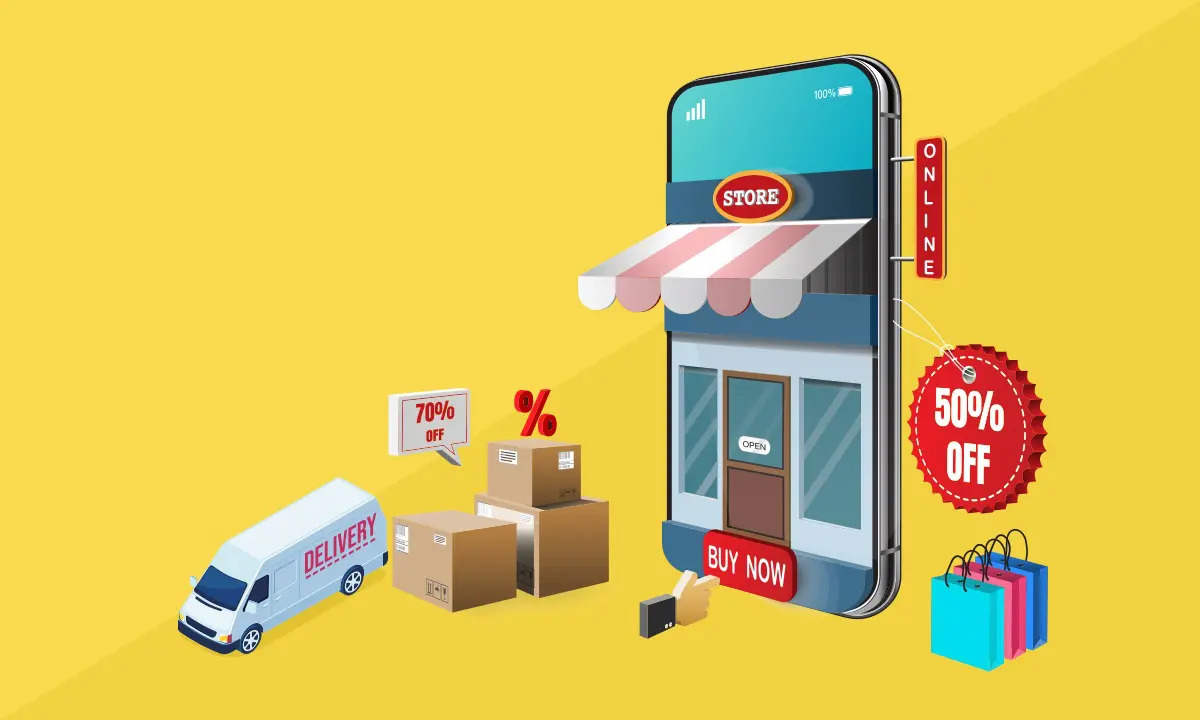Discover how the recent corona crisis has impacted the retail industry, resulting in a significant boost for eCommerce. Explore the limitless potential of the internet, its resilience during lockdowns, and the shift in consumer behavior.
According to a report from BusinessWire, global online sales experienced a significant 16.5% boost in 2022. Furthermore, recent reports by Statista predict that by the year’s end, eCommerce will account for approximately 22% of global retail sales. These numbers clearly indicate that the eCommerce industry is growing increasingly competitive by the day. In order to stay ahead and overcome the challenges it presents, eCommerce business owners must stay up-to-date with the latest industry trends.
The landscape of eCommerce trends is ever-evolving, and the upcoming years are no exception. In this article, we will delve into some of the most significant trends and explore effective strategies to tackle the major challenges faced by the eCommerce industry. So, without further delay, let’s dive right in!
Ecommerce Trends: Shaping the Path to the Future
1/ Augmented reality has become the prevailing standard
One of the main concerns for online shoppers is the inability to try on or interact with products as they would in a physical store. However, Augmented Reality (AR) has revolutionized the eCommerce landscape, offering a solution to this drawback. By leveraging AR technology, shoppers can now visualize product placement and even try on items virtually before making a purchase. This not only aids in their decision-making process but also enhances the overall shopping experience. In fact, Google has reported that 66% of people are interested in using AR for shopping, and this trend is expected to gain even more momentum in 2022.

Considering these advancements, here are three compelling reasons why you should consider incorporating Augmented Reality shopping for your customers.
Enhanced Conversion
Providing shoppers with a clear understanding of their potential purchases increases the likelihood of conversion and encourages repeat visits to your platform. In essence, offering consumers an interactive shopping experience can have a significant impact on your website’s conversion rates.
Decreased return rates
It’s no surprise that customers often return purchased items when they fail to meet expectations. Whether it’s a different color than envisioned or doesn’t complement their home decor, the reasons are endless. This is where Augmented Reality comes into play, revolutionizing the purchasing decisions of buyers. By allowing customers to try products with AR, they can be confident in their purchase, leading to a drastic reduction in return rates. Ultimately, customer satisfaction soars, thanks to the power of Augmented Reality.
Tailored experience
Offering customers a personalized experience is not just a passing trend, but a powerful tool that we will delve into later. With the help of augmented reality (AR), personalized experiences are akin to browsing through clothes on mannequins or models. Imagine finding your perfect size and receiving tailored recommendations while shopping online. This level of customization provided by AR is bound to drive up sales.
2/ The popularity of Voice Search is skyrocketing
Voice search allows users to multitask, saving time and eliminating the hassle of typing queries. With the rise of the internet of things, smart speakers like Siri and Amazon’s Alexa have become a daily necessity for many. It is projected that by 2025, 75% of U.S. households will own a smart speaker.
As smart speakers become more prevalent, the adoption of voice search will increase. This technology can be used for various tasks such as food ordering, organization, and online shopping. Consequently, the eCommerce industry has a unique opportunity to optimize keywords and content. By executing a well-planned keyword strategy, your eCommerce store can achieve top rankings on Google and attract more customers.

3/ A customized experience has transformed into an indispensable requirement
Personalized eCommerce experiences involve tailored product suggestions and targeted emails based on visitor activity. Research by Segment shows that over 60% of consumers are more likely to become repeat buyers with personalized experiences.
Customers now expect proactive businesses offering relevant suggestions. Personalization eliminates the need to search elsewhere, increasing purchase likelihood. Amazon’s successful implementation showcases product recommendations based on buyer actions.
Tailored experiences enhance customer engagement and foster loyalty. Localization involves adapting the site to the target market, including content and reflecting local interests and values.
4/ Enhancing the Shopping Experience with Chatbots
Chatbots engage shoppers like sales associates in physical stores. Shoppers desire convenience and easy product discovery and purchase. If not provided, frustration sets in. Enter chatbots to save the day.
Imagine this scenario: your business faces overwhelming repetitive queries in call centers and email inboxes, but limited customer support resources. Dissatisfied customers and sales at risk. That’s why investing in chatbots is crucial.
Still skeptical? Let’s look at some compelling figures. Gartner predicts that by 2020, 85% of customer interactions will be handled by chatbots. They also found that 53% of customers prefer messaging over phone calls for customer service. IBM estimates businesses using chatbots will save $8 billion by 2022. Chatbots require a one-time investment instead of ongoing salaries for support staff, making it a sound investment.
L’Oréal is a notable chatbot success story. They recognized the importance of enhancing customer experience and brand awareness. After thorough research, they chose Facebook Messenger as their messaging platform and launched the “find the perfect fragrance” chatbot. This interactive virtual fragrance consultant improved shopping experiences for 75% of users.
By leveraging chatbots, businesses can revolutionize interactions, drive sales, and elevate the shopping journey.

5/ The world of Mobile Commerce is constantly evolving and progressing
Mobile shopping is now essential, allowing customers to make purchases anywhere. The convenience of accessing a wide range of products, conducting thorough research, and shopping from the comfort of your couch cannot be overstated.
However, failing to make your eCommerce website mobile responsive means missing out on tremendous growth opportunities. The exponential rise of mobile shopping has prompted brands to adapt to this trend.
To align with this technology trends, create a mobile-friendly eCommerce store. Opt for a responsive design, optimize product presentation, and streamline the checkout process. Platforms like Shopify or BigCommerce offer integrations and features to enhance the shopping experience.
Embrace mobile shopping and position your brand for success in the digital marketplace.
6/ Expanded Payment Options
In past, payments were limited to credit or debit cards. Then came PayPal, aiming to simplify payments. However, today’s online consumers seek diverse payment options. The more options available on your website, the higher the likelihood of customer purchases from your online store.
One emerging trend is the use of digital wallets like Venmo. It allows customers to pay through its app or by scanning a QR code specific to your business. Another popular payment method gaining traction in eCommerce is Buy Now Pay Later (BNPL) options. For instance, PayPal’s Pay in Four enables customers to pay for larger purchases in installments. Interestingly, these options don’t require credit checks or traditional financing.
By embracing a wider range of payment solutions, you can enhance the shopping experience for customers and drive more sales to your online store.
Challenges Faced by Ecommerce Businesses
1/ Consistency is key
Cons is key in crafting an effective omnichannel strategy. Customers now use multiple platforms to search for products before purchasing. Businesses must ensure a seamless experience across all touchpoints. However, analyzing customer interactions and leveraging that knowledge for a cohesive customer journey is a challenge for eCommerce.
So, how can retailers overcome this? By optimizing their online platforms. By optimizing online stores, brands can provide a consistent experience in search options, shopping pages, and shipping details. This ensures a seamless shopping experience, leaving customers satisfied. Additionally, focus on enhancing product quality, fulfillment, and distribution. Prioritizing consistency and improving the customer journey helps businesses thrive in the competitive eCommerce landscape.
2/ Ensuring the security of data
Robust eCommerce security is crucial for success in the industry. As eCommerce grows, security concerns also increase. Hackers target host servers to steal data or inject viruses, posing a threat to businesses and shoppers.
Credit and debit card breaches are unfortunately common, damaging user trust. Phishing is another concern when collecting sensitive information from consumers. Users worry about the ability of eCommerce websites to protect their identities and transactions.
To safeguard brand reputation and attract customers, online businesses must prioritize addressing security concerns. Transitioning to HTTP protocols and using reputable payment methods can enhance platform security. Obtaining Payment Card Industry Data Security Standard (PCI DSS) accreditation provides further protection for businesses and customer data.

3/ Improving Customer Retention
Customer retention poses a challenge, even for the eCommerce giants. This challenge encompasses various factors like customer expectations, competition, and the failure to create tailored shopping experiences. Maintaining customer loyalty is crucial for business success, as even minor service glitches can impact it. Unfortunately, many businesses underestimate the value of customer loyalty and fail to recognize that it’s an integral part of fostering long-lasting relationships.
To effectively engage customers, businesses should go beyond transactional interactions and make customers feel valued. While providing an exceptional platform experience is important, brands must also nurture customers through personalized communication across various channels. By establishing an emotional connection with the brand, businesses can cultivate customer loyalty and transform customers into brand advocates.
Creating a strategic customer retention plan can work wonders for the brand, solidifying the bond with customers and turning them into enthusiastic promoters.
4/ Targeted Prospects
Driving traffic to eCommerce websites through marketing is achievable, but obtaining relevant leads remains a challenge. Average eCommerce conversion rates are minimal, with only 2.57% of eCommerce website visitors in the U.S. making a purchase, according to a report.
The challenge lies in targeting the right audience at the right time with a desired product. Brands often struggle to effectively communicate the value of their product or service, resulting in a failure to engage interested audiences.
Implementing an efficient marketing strategy can greatly enhance your platform. For example, optimizing your brand for search engines can improve page rankings and reach potential customers actively. Running Google pay-per-click ads can effectively convey information and capture the attention of genuinely interested audiences.
Follow-ups are crucial for marketers. Personalized emails can work wonders in establishing connections with visitors who may eventually become valuable prospects.
5/ Abandoned Carts
High cart abandonment rates can be attributed to various factors, with unsatisfactory user experience being the most common. Slow loading pages, complex checkout processes, and insecure payment methods are among the culprits.
So, how can this problem be tackled? It’s simple. The buying process should be seamless and effortless. Simplify the checkout procedures, ensuring that they can be completed in under a minute.
Moreover, transparent pricing, intuitive navigation, and quick loading pages are crucial to guide customers smoothly through the purchase journey. Additionally, retargeting customers who abandoned their carts and enticing them with personalized offers can yield positive results.
In summary,
2023 holds great promise for eCommerce, but it also presents challenges that businesses must effectively address. While sales are expected to grow, retailers and business owners must prioritize enhancing the customer’s shopping experience. It is crucial to stay aware of the strategies that are driving success in the eCommerce industry and to overcome the obstacles that stand in the way of eCommerce businesses’ triumph.
STDIO ASIA is renowned for creating customized applications specifically designed for eCommerce. Discover our exceptional expertise firsthand and schedule a call with us today!



Leave a Reply